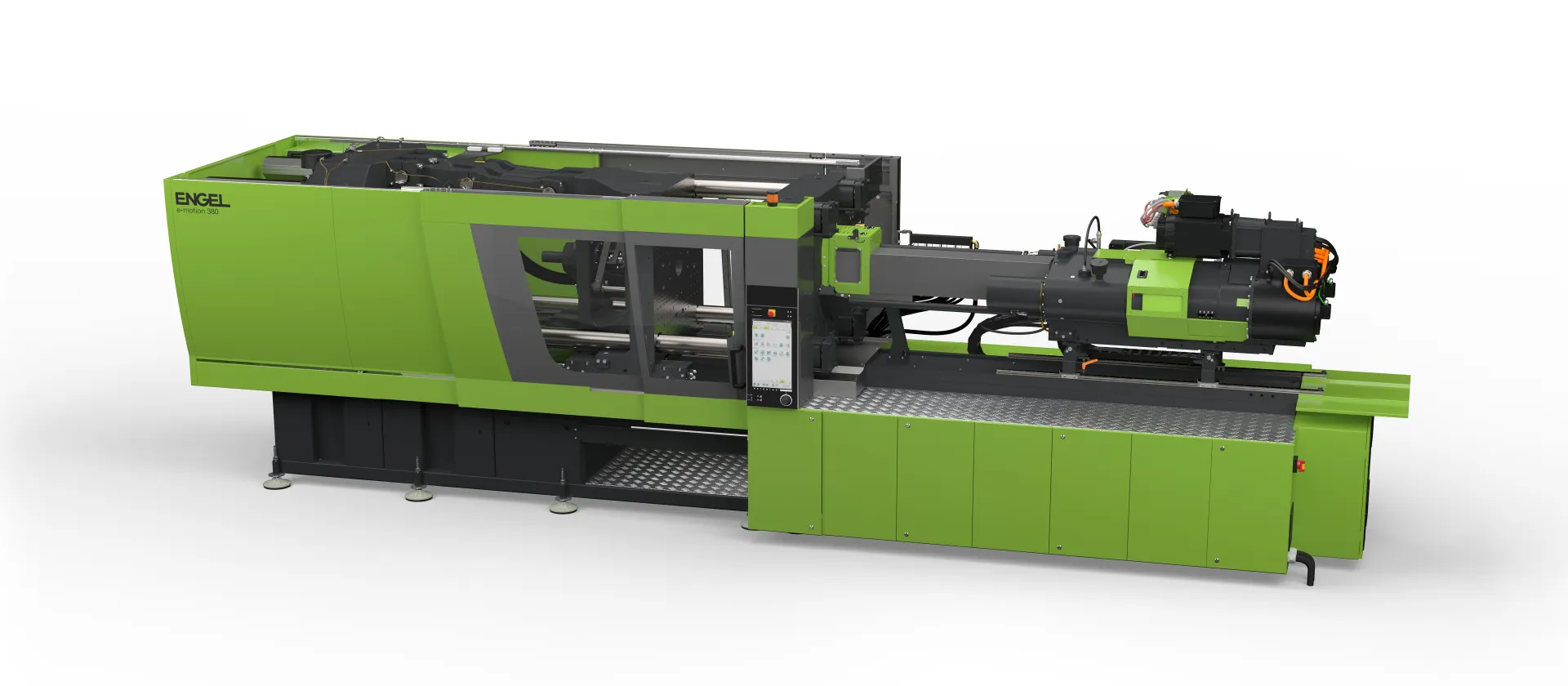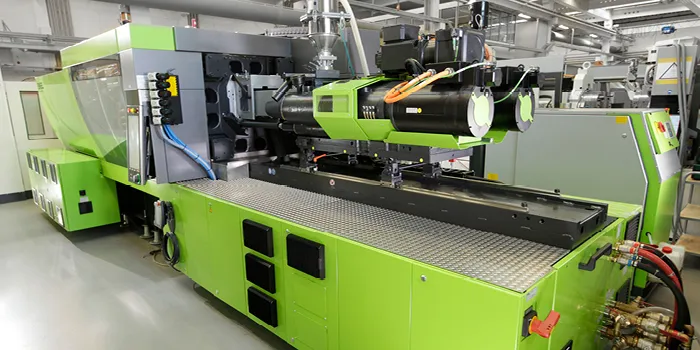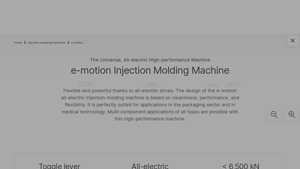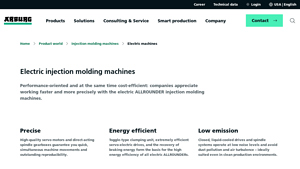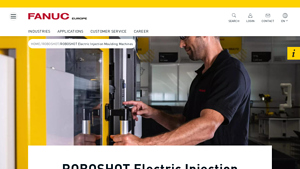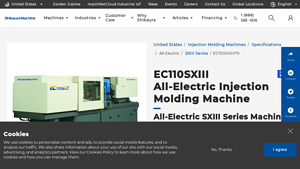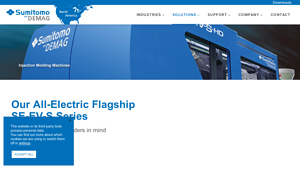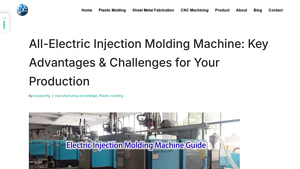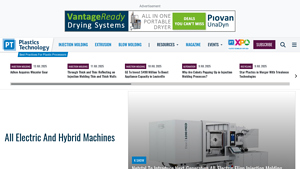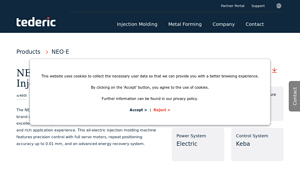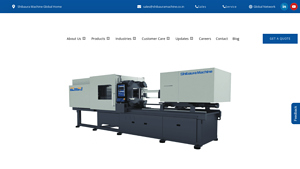All-Electric Injection Molding Machine Guide: Type, Cost, Top List…
Introduction: Navigating the Global Market for all-electric injection molding machine
In an era where sustainability and efficiency are paramount, the demand for all-electric injection molding machines has surged globally. However, navigating the complexities of sourcing these advanced machines can pose significant challenges for B2B buyers, particularly those in emerging markets such as Nigeria, Brazil, and the Middle East. This guide is designed to empower international buyers by providing a comprehensive overview of all-electric injection molding machines, including various types, applications across industries, and critical factors to consider when vetting suppliers.
As manufacturers seek to enhance their production capabilities while minimizing energy consumption and operational costs, understanding the nuances of all-electric systems becomes essential. This guide will delve into the unique features that set all-electric machines apart from their hydraulic counterparts, such as energy efficiency, precision, and reduced emissions. Additionally, we will explore the cost implications and potential return on investment associated with these machines, enabling buyers to make informed purchasing decisions that align with their operational goals.
By equipping buyers with actionable insights and a clear framework for evaluating options, this guide aims to facilitate a smoother procurement process. It addresses the specific needs and challenges faced by businesses in Africa, South America, the Middle East, and Europe, ensuring that decision-makers are well-prepared to invest in the right solutions for their manufacturing needs.
Understanding all-electric injection molding machine Types and Variations
| Type Name | Key Distinguishing Features | Primary B2B Applications | Brief Pros & Cons for Buyers |
|---|---|---|---|
| e-motion Series | High-performance with customizable control, compact design | Packaging, medical technology, multi-component products | Pros: Energy-efficient, flexible; Cons: Higher initial investment. |
| ALLROUNDER Series | Versatile, high precision, energy-efficient servo drives | Automotive, clean room, micro injection | Pros: Low emissions, space-saving; Cons: Complexity in setup. |
| Victory Electric | Tie-barless design, adaptable clamping, short cycle times | High-volume production, clean room applications | Pros: Compact, efficient; Cons: Limited clamping force options. |
| ALLDRIVE Series | Direct-acting, customizable performance, smart control system | High-precision applications across industries | Pros: High accuracy, low energy consumption; Cons: Requires skilled operators. |
| GOLDEN ELECTRIC | Entry-level model, standardized technology for efficiency | Small to medium production runs | Pros: Cost-effective, user-friendly; Cons: Limited advanced features. |
What are the Key Characteristics of the e-motion Series?
The e-motion series of all-electric injection molding machines is designed for high performance and flexibility, making it suitable for demanding applications in packaging and medical technology. Its integrated control system allows for customizable configurations, enabling companies to optimize production according to their specific needs. Buyers should consider its energy efficiency and compact design, which not only reduce operational costs but also save valuable floor space. However, the initial investment can be higher compared to hydraulic machines.
How Does the ALLROUNDER Series Stand Out?
The ALLROUNDER series is recognized for its versatility and precision, featuring high-quality servo motors that ensure quick and accurate machine movements. This series is particularly beneficial for industries such as automotive and clean room applications, where precision and low emissions are critical. Companies should evaluate their production needs against the machine’s capabilities, as its complexity may require skilled operators for optimal performance.
What Advantages Does the Victory Electric Offer?
The Victory Electric model is characterized by its tie-barless design, allowing for adaptable clamping and significantly reduced cycle times. This machine is ideal for high-volume production and clean room environments, where efficiency and cleanliness are paramount. Buyers should appreciate the compactness of this machine, which aids in maximizing production space. However, potential limitations in clamping force may restrict its use for certain applications.
Why Choose the ALLDRIVE Series for High-Precision Needs?
The ALLDRIVE series offers direct-acting capabilities and customizable performance features, making it suitable for high-precision applications across various industries. Its smart control system enhances operational efficiency and accuracy, which is essential for manufacturers aiming for high-quality output. While the energy consumption is notably low, companies must be prepared for the need for skilled personnel to manage the machine effectively.
What Makes the GOLDEN ELECTRIC an Ideal Entry-Level Option?
The GOLDEN ELECTRIC model serves as an excellent entry-level option for businesses looking to integrate all-electric technology without breaking the bank. It employs standardized technology that promotes efficiency and ease of use, making it suitable for small to medium production runs. However, buyers should note that its limited advanced features may not meet the needs of more complex manufacturing processes, making it essential to assess future scalability when considering this option.
Key Industrial Applications of all-electric injection molding machine
| Industry/Sector | Specific Application of all-electric injection molding machine | Value/Benefit for the Business | Key Sourcing Considerations for this Application |
|---|---|---|---|
| Packaging | Production of thin-wall containers for food and consumer goods | Enhanced efficiency and reduced material waste | Energy efficiency, cycle time, and machine footprint |
| Medical Technology | Manufacturing precision medical devices and components | High accuracy and compliance with stringent hygiene standards | Clean room compatibility, precision control, and automation options |
| Automotive | Production of high-performance automotive parts | Improved durability and lightweight solutions | Ability to handle complex geometries and multi-component molding |
| Electronics | Fabrication of small, intricate electronic housings | Superior precision and reduced energy consumption | High-speed production capabilities and integration with automation |
| Consumer Goods | Creation of custom molded products, such as toys and household items | Flexibility in design and rapid prototyping capabilities | Adaptability for various materials and ease of maintenance |
How are all-electric injection molding machines utilized in key industries?
Packaging
All-electric injection molding machines are pivotal in the packaging industry, particularly for producing thin-wall containers used in food and consumer goods. These machines enable manufacturers to achieve high production rates while minimizing material waste. For international buyers, especially in regions like Africa and South America, sourcing machines that offer energy efficiency and reduced cycle times is crucial for maintaining competitive pricing and meeting sustainability goals.
Medical Technology
In the medical sector, all-electric injection molding machines are essential for the production of precision medical devices, such as syringes and surgical instruments. These machines ensure high accuracy and compliance with stringent hygiene standards, which are critical in this industry. Buyers from Europe and the Middle East should prioritize machines that are compatible with clean room environments, as well as those that offer advanced automation features to enhance productivity and maintain product integrity.
Automotive
All-electric injection molding machines are increasingly used in the automotive industry for the production of high-performance parts, such as dashboards and engine components. The ability to create lightweight yet durable components is essential for meeting modern automotive standards. B2B buyers in regions like Nigeria and Brazil should focus on sourcing machines that can handle complex geometries and provide multi-component molding capabilities to support the evolving demands of the automotive market.
Electronics
In the electronics sector, these machines facilitate the fabrication of small, intricate housings for devices like smartphones and tablets. Their superior precision and reduced energy consumption make them ideal for high-speed production. Buyers should consider sourcing machines that integrate seamlessly with automation systems to optimize production efficiency and reduce lead times, particularly in competitive markets.
Consumer Goods
All-electric injection molding machines are also employed to create custom molded products, such as toys and household items. The flexibility in design and rapid prototyping capabilities offered by these machines allow businesses to innovate quickly and respond to market trends. For international buyers, ensuring that the machines can adapt to various materials and offer ease of maintenance is vital for sustaining long-term operational efficiency.
3 Common User Pain Points for ‘all-electric injection molding machine’ & Their Solutions
Scenario 1: Navigating High Energy Costs in Production
The Problem: Many manufacturers in emerging markets, particularly in Africa and South America, face significant energy costs that can erode profit margins. All-electric injection molding machines, while known for their efficiency, can still lead to high operational expenses if not properly managed. This is particularly challenging for businesses that operate in regions with fluctuating electricity prices and limited access to affordable energy sources. Buyers may struggle to understand how to maximize energy efficiency while maintaining production output.
The Solution: To mitigate high energy costs, buyers should look for all-electric injection molding machines equipped with advanced servo-electric drives, which provide precise control over movements and energy usage. When sourcing machines, request models that feature energy recovery systems, allowing them to reclaim and reuse energy during operations. Additionally, consider implementing smart monitoring systems that track energy consumption in real-time, enabling proactive adjustments to production schedules during peak energy pricing periods. Investing in training for staff on energy-efficient operating practices can further enhance savings, ensuring that the machines operate within their optimal energy parameters.
Scenario 2: Ensuring Consistent Quality in Production
The Problem: Maintaining product quality is a major concern for manufacturers using all-electric injection molding machines. Variability in raw materials, machine calibration, and environmental conditions can lead to inconsistent product quality, particularly in sectors like medical technology or packaging where precision is critical. Buyers may find it difficult to achieve the necessary reproducibility without incurring additional costs or downtime for recalibration and testing.
The Solution: To ensure consistent quality, buyers should prioritize machines that come with advanced control systems capable of adaptive learning and real-time adjustments. Look for all-electric injection molding machines with features such as direct-acting servo-electric dosage drives, which allow for precise control over injection speed and pressure. Implementing a robust quality assurance program that includes regular calibration checks and maintenance schedules can help to prevent quality drift. Additionally, consider establishing partnerships with suppliers that offer high-quality, consistent raw materials, and invest in training for operators to understand the nuances of machine settings and their impacts on product quality.
Scenario 3: Managing Space Constraints in Production Facilities
The Problem: In densely populated manufacturing environments, such as those common in Europe and parts of the Middle East, space is often at a premium. Buyers may find that traditional injection molding machines take up too much floor space, leading to inefficiencies and increased operational costs. This problem is exacerbated when companies need to integrate automation solutions or additional machinery into their production lines.
The Solution: Buyers should seek all-electric injection molding machines that are designed with a compact footprint. Many modern models feature a space-saving design and can integrate seamlessly with other automation systems, such as conveyor belts and robotics, without requiring significant additional floor space. When sourcing machinery, evaluate options that offer modular designs and can be easily reconfigured as production needs change. Implementing a lean manufacturing approach can also help optimize layout and workflow, ensuring that every inch of production space is utilized efficiently. Furthermore, consider using simulation software to plan and visualize the production layout before installation, allowing for a strategic approach to space management.
Strategic Material Selection Guide for all-electric injection molding machine
What Are the Key Materials Used in All-Electric Injection Molding Machines?
When considering all-electric injection molding machines, the selection of materials is crucial for optimizing performance, durability, and cost-effectiveness. Below, we analyze four common materials used in this context, focusing on their properties, advantages, disadvantages, and specific considerations for international B2B buyers.
How Does Polypropylene (PP) Perform in All-Electric Injection Molding?
Polypropylene is a widely used thermoplastic polymer known for its versatility. It boasts a temperature rating of up to 100°C and excellent chemical resistance, making it suitable for various applications, including packaging and automotive components.
Pros: Polypropylene is lightweight, cost-effective, and has a high impact resistance. Its manufacturing process is relatively straightforward, allowing for efficient production cycles.
Cons: While durable, polypropylene can be susceptible to environmental stress cracking and may not perform well under high-temperature conditions.
Impact on Application: PP is compatible with a range of media, making it ideal for food packaging and automotive parts. However, its limitations in high-temperature applications should be considered.
Considerations for International Buyers: Compliance with standards such as ASTM D638 for tensile properties is essential. Buyers in regions like Africa and South America should ensure that the material meets local regulations for food safety.
What Are the Advantages of Using Acrylonitrile Butadiene Styrene (ABS)?
ABS is a popular choice for applications requiring toughness and impact resistance. It has a temperature rating of approximately 80°C and is known for its excellent surface finish.
Pros: ABS offers high durability and is easy to machine, making it suitable for complex shapes. Its aesthetic appeal is also a significant advantage for consumer products.
Cons: The material has a higher cost compared to polypropylene and can be less environmentally friendly due to its production process.
Impact on Application: ABS is ideal for electronic housings, automotive interiors, and consumer goods. Its ability to withstand impact makes it suitable for products that require durability.
Considerations for International Buyers: Buyers should verify compliance with international standards such as ISO 527 for tensile strength. In regions like Europe, ensuring adherence to REACH regulations is crucial.
Why Choose Polycarbonate (PC) for High-Performance Applications?
Polycarbonate is known for its high impact resistance and optical clarity, making it suitable for applications requiring transparency and strength. It can withstand temperatures up to 120°C.
Pros: PC is exceptionally durable and can be molded into complex shapes. Its transparency allows for innovative design applications in lighting and safety equipment.
Cons: It is more expensive than both PP and ABS and can be prone to scratching unless treated.
Impact on Application: PC is commonly used in safety goggles, automotive parts, and electronic components. Its high-performance characteristics make it ideal for demanding environments.
Considerations for International Buyers: Compliance with ASTM D256 for impact resistance is vital. Buyers in regions like the Middle East should consider the material’s performance under varying climatic conditions.
What Role Does Polyethylene Terephthalate (PET) Play in Injection Molding?
PET is a thermoplastic polymer known for its strength and recyclability. It has a temperature rating of around 70-80°C and excellent chemical resistance.
Pros: PET is highly durable and has a low moisture absorption rate, making it suitable for packaging applications. Its recyclability is a significant advantage in today’s eco-conscious market.
Cons: The material can be more challenging to process than other thermoplastics, potentially increasing manufacturing complexity.
Impact on Application: PET is widely used in beverage bottles and food containers. Its compatibility with various media makes it a preferred choice for packaging.
Considerations for International Buyers: Compliance with FDA regulations for food contact materials is essential. Buyers in South America and Africa should ensure that the material meets local recycling standards.
Summary of Material Selection for All-Electric Injection Molding Machines
| Material | Typical Use Case for all-electric injection molding machine | Key Advantage | Key Disadvantage/Limitation | Relative Cost (Low/Med/High) |
|---|---|---|---|---|
| Polypropylene (PP) | Packaging, automotive components | Lightweight and cost-effective | Susceptible to environmental stress cracking | Low |
| Acrylonitrile Butadiene Styrene (ABS) | Consumer goods, electronic housings | High durability and aesthetic appeal | Higher cost and less eco-friendly | Med |
| Polycarbonate (PC) | Safety goggles, automotive parts | High impact resistance and transparency | More expensive and prone to scratching | High |
| Polyethylene Terephthalate (PET) | Beverage bottles, food containers | Durable and recyclable | More challenging to process | Med |
This strategic material selection guide provides B2B buyers with essential insights into the materials best suited for all-electric injection molding machines, facilitating informed purchasing decisions tailored to specific regional requirements and compliance standards.
In-depth Look: Manufacturing Processes and Quality Assurance for all-electric injection molding machine
What Are the Key Manufacturing Processes for All-Electric Injection Molding Machines?
Manufacturing all-electric injection molding machines involves several critical stages, each designed to ensure precision, efficiency, and quality. Understanding these processes can help B2B buyers from regions such as Africa, South America, the Middle East, and Europe make informed decisions when selecting suppliers.
What Are the Main Stages of Manufacturing All-Electric Injection Molding Machines?
-
Material Preparation
The manufacturing process begins with the careful selection and preparation of materials. The key components of an all-electric injection molding machine, such as the frame, clamping unit, and injection unit, are typically made from high-quality steel and aluminum. These materials are selected for their strength, durability, and resistance to wear. Initial steps include cutting, machining, and treating the materials to enhance their properties, such as hardness and corrosion resistance. -
Forming
Forming is the stage where the prepared materials are shaped into the machine components. This process often employs advanced techniques such as CNC machining, laser cutting, and injection molding of smaller parts. The forming process must ensure that each component meets precise specifications, which is crucial for the overall performance of the machine. -
Assembly
Once the components are formed, they undergo a meticulous assembly process. This stage involves integrating various parts such as the control system, servo motors, and clamping units. The assembly is typically carried out in a clean environment to prevent contamination, particularly for machines designed for medical or high-precision applications. Workers use specialized tools and fixtures to ensure that every component is correctly aligned and secured. -
Finishing
The finishing stage includes surface treatments, painting, and the application of protective coatings to enhance the machine’s aesthetic appeal and durability. Additionally, this stage may involve final adjustments to the machine’s settings to ensure optimal performance. Quality checks are crucial during this phase to verify that all components function seamlessly together.
How Is Quality Assurance Implemented in Manufacturing All-Electric Injection Molding Machines?
Quality assurance (QA) is paramount in the production of all-electric injection molding machines, ensuring that every unit meets international standards and customer expectations. B2B buyers should be aware of the various QA practices employed by manufacturers.
What Are the Relevant International Standards for Quality Assurance?
Manufacturers of all-electric injection molding machines typically adhere to several international standards, including:
-
ISO 9001: This standard focuses on quality management systems and is crucial for ensuring consistent quality in manufacturing processes. Companies certified to ISO 9001 demonstrate their commitment to continuous improvement and customer satisfaction.
-
CE Marking: For machines sold in the European market, CE marking indicates compliance with health, safety, and environmental protection standards. This certification is essential for gaining access to the European market and assures buyers of the machine’s safety and reliability.
-
API Standards: In specific applications, such as those involving plastic components for the oil and gas industry, compliance with API standards may be necessary. These standards ensure that the products meet industry-specific requirements for safety and performance.
What Are the Key Quality Control Checkpoints in the Manufacturing Process?
Quality control (QC) checkpoints are critical for maintaining high standards throughout the manufacturing process. Common checkpoints include:
-
Incoming Quality Control (IQC): This stage involves inspecting raw materials and components upon arrival to ensure they meet specified quality standards. Any materials that do not meet these standards are rejected or returned.
-
In-Process Quality Control (IPQC): Throughout the manufacturing process, various inspections are performed to monitor quality. This includes checking dimensions, tolerances, and operational parameters of machinery during assembly.
-
Final Quality Control (FQC): Before the machines are shipped, a final inspection is conducted to verify that the completed units meet all specifications and standards. This may include testing the machine’s operational capabilities and performance metrics.
What Testing Methods Are Commonly Used in Quality Assurance for All-Electric Injection Molding Machines?
Testing methods play a crucial role in the QC process for all-electric injection molding machines. B2B buyers should be familiar with these methods to understand the reliability of their potential suppliers.
-
Functional Testing: Each machine undergoes functional testing to ensure all components operate as intended. This may include testing the injection unit’s speed, precision, and energy consumption.
-
Performance Testing: Manufacturers may conduct performance tests to evaluate the machine’s efficiency under various operating conditions. This helps identify any potential issues before the machine is delivered to the customer.
-
Durability Testing: To ensure long-term reliability, machines may be subjected to durability tests that simulate extended usage. This helps verify that the machine can withstand the demands of high-volume production environments.
How Can B2B Buyers Verify Supplier Quality Control Practices?
For B2B buyers, particularly those in regions like Africa, South America, the Middle East, and Europe, verifying a supplier’s QC practices is essential for ensuring product quality and reliability.
What Steps Can Buyers Take to Assess Supplier Quality Control?
-
Conduct Audits: Buyers can request to conduct on-site audits of the manufacturing facilities. This allows them to observe the QC processes in place and assess the overall manufacturing environment.
-
Request Documentation: Suppliers should provide documentation of their quality management systems, including ISO certifications, QC reports, and testing results. Reviewing these documents helps buyers understand the supplier’s commitment to quality.
-
Utilize Third-Party Inspection Services: Engaging third-party inspection companies can provide an unbiased assessment of the supplier’s manufacturing processes and QC practices. These services can verify compliance with international standards and ensure that the machines meet specified requirements.
What Are the Quality Control Nuances for International B2B Buyers?
International B2B buyers must be aware of specific nuances in QC practices that may vary by region. Understanding these differences can help mitigate risks associated with sourcing equipment globally.
-
Regulatory Compliance: Different regions may have varying regulations regarding manufacturing and product safety. Buyers must ensure that their suppliers are compliant with local laws and international standards relevant to their market.
-
Cultural Considerations: Communication styles and business practices may differ across cultures. Buyers should establish clear expectations and maintain open lines of communication to ensure that quality standards are met.
-
Logistics and Supply Chain Factors: The complexity of international logistics can impact the delivery and quality of machinery. Buyers should consider the supplier’s ability to manage logistics effectively and maintain product integrity throughout the shipping process.
By understanding the manufacturing processes and quality assurance practices for all-electric injection molding machines, B2B buyers can make informed decisions that align with their operational needs and quality standards. This knowledge empowers buyers to select reliable suppliers that deliver high-quality, efficient machinery suited to their specific applications.
Practical Sourcing Guide: A Step-by-Step Checklist for ‘all-electric injection molding machine’
Introduction
Sourcing an all-electric injection molding machine is a strategic investment that can significantly enhance production efficiency and reduce operational costs. This checklist serves as a practical guide for international B2B buyers, particularly in regions like Africa, South America, the Middle East, and Europe, to ensure a thorough procurement process. By following these steps, you can make informed decisions that align with your operational needs and sustainability goals.
Step 1: Define Your Technical Specifications
Establishing clear technical specifications is the foundation of your sourcing journey. This includes determining the clamping force, injection speed, and cycle times that meet your production requirements.
– Consider the material types you will be processing and the complexity of your molds to ensure compatibility with the machine’s capabilities.
– Assess energy efficiency needs, as all-electric machines vary in power consumption based on their design and technology.
Step 2: Evaluate Supplier Experience and Reputation
Research potential suppliers to gauge their industry experience and reputation. A supplier with a proven track record in all-electric injection molding will likely provide better support and reliability.
– Request case studies or testimonials from companies in similar industries or regions.
– Check for industry certifications that validate their quality standards and practices.
Step 3: Assess Machine Performance and Efficiency
Prioritize suppliers that provide detailed performance metrics for their machines. All-electric models are designed for high efficiency, but specifics can vary widely between manufacturers.
– Look for energy consumption data and compare it against traditional hydraulic machines to quantify potential savings.
– Inquire about cycle times and production capacity to ensure they align with your operational goals.
Step 4: Verify Supplier Certifications
Confirm that potential suppliers meet relevant industry standards and certifications. This is crucial for ensuring quality and compliance, especially in highly regulated sectors such as medical or food packaging.
– Request ISO certifications or other relevant quality management standards.
– Ensure compliance with local regulations in your region to avoid future legal complications.
Step 5: Consider After-Sales Support and Maintenance
After-sales support is vital for the longevity and efficiency of your investment. Investigate what services suppliers offer post-purchase, including maintenance, training, and spare parts availability.
– Ask about service packages that can be customized to fit your operational needs.
– Evaluate the availability of training programs for your staff to maximize the machine’s capabilities and reduce downtime.
Step 6: Review Cost and Financing Options
Finally, assess the total cost of ownership, including purchase price, installation, and operating expenses. Understanding financing options can also aid in budget management.
– Request detailed quotes that break down all costs involved.
– Explore financing solutions offered by suppliers or third-party institutions to ease the financial burden.
By following this step-by-step checklist, you will be better equipped to select an all-electric injection molding machine that meets your operational needs while optimizing performance and sustainability.
Comprehensive Cost and Pricing Analysis for all-electric injection molding machine Sourcing
What are the Key Cost Components in Sourcing All-Electric Injection Molding Machines?
When sourcing all-electric injection molding machines, understanding the cost structure is crucial. The primary cost components include:
-
Materials: The cost of high-quality materials used in manufacturing the machines, such as aluminum or steel for the frame and specialized plastics for components. The selection of materials can significantly impact both the durability and performance of the machine.
-
Labor: Labor costs encompass wages for skilled technicians and engineers involved in the design, assembly, and quality control processes. In regions with a skilled labor shortage, such as parts of Africa and South America, labor costs may be higher.
-
Manufacturing Overhead: This includes costs related to facility maintenance, utilities, and equipment depreciation. Efficient production processes can help mitigate these overhead costs.
-
Tooling: Specialized tooling may be required for the production of specific machine components. This is often a significant upfront investment and can affect the overall pricing structure.
-
Quality Control (QC): Implementing rigorous QC processes ensures the machines meet industry standards and specifications. The costs associated with testing and certification should be factored into the total price.
-
Logistics: Shipping costs can vary widely based on location, weight, and shipping method. For international buyers, understanding Incoterms is essential to clarify who bears the shipping costs and responsibilities.
-
Margin: Suppliers will typically include a margin to cover their business risks and operational costs. This margin can vary based on market conditions and the supplier’s positioning.
How Do Price Influencers Affect the Cost of All-Electric Injection Molding Machines?
Several factors can influence the pricing of all-electric injection molding machines:
-
Volume/MOQ: Bulk orders can lead to significant discounts. Understanding the minimum order quantities (MOQ) and negotiating favorable terms can lead to cost savings.
-
Specifications and Customization: Machines that require customization to meet specific production needs can incur additional costs. Buyers should carefully evaluate whether custom features are necessary or if standard models suffice.
-
Materials and Quality Certifications: The choice of materials and the presence of quality certifications (ISO, CE, etc.) can affect pricing. Machines with higher quality standards typically command a premium price.
-
Supplier Factors: The reputation and reliability of the supplier can impact pricing. Established suppliers with a track record of quality and service may charge higher prices but offer better long-term value.
-
Incoterms: Understanding shipping terms is critical. For example, “FOB” (Free on Board) means the seller covers costs until the goods are loaded onto a shipping vessel, while “CIF” (Cost, Insurance, and Freight) includes shipping and insurance costs, impacting the overall purchase price.
What Buyer Tips Can Enhance Cost-Efficiency When Sourcing All-Electric Injection Molding Machines?
International B2B buyers should consider the following strategies for effective sourcing:
-
Negotiate Terms: Always negotiate pricing and terms with suppliers. Engage in discussions about bulk discounts, payment terms, and warranty conditions.
-
Evaluate Total Cost of Ownership (TCO): Look beyond the initial purchase price. Consider energy efficiency, maintenance costs, and potential downtime, as these factors significantly influence the TCO over the machine’s lifespan.
-
Research Market Pricing: Be informed about market rates for all-electric injection molding machines. This knowledge can empower you during negotiations and help you identify fair pricing.
-
Understand Pricing Nuances for International Markets: Be aware of regional variations in pricing due to factors such as tariffs, import duties, and local market conditions, particularly in regions like Africa and South America.
-
Seek Multiple Quotes: Obtaining quotes from multiple suppliers allows for comparative analysis, helping to identify the best value.
Conclusion
While sourcing all-electric injection molding machines involves various cost components and price influencers, informed decision-making can lead to significant savings and improved operational efficiency. By understanding these elements and employing effective negotiation strategies, international buyers can secure optimal solutions tailored to their specific needs. Always remember to consult with industry experts or local representatives to navigate complexities associated with international procurement effectively.
Alternatives Analysis: Comparing all-electric injection molding machine With Other Solutions
Understanding the Alternatives to All-Electric Injection Molding Machines
In the competitive landscape of manufacturing, particularly in sectors such as packaging and medical technology, selecting the right injection molding solution is paramount. All-electric injection molding machines are lauded for their energy efficiency and precision. However, businesses may also consider alternative solutions, each with distinct advantages and disadvantages. This analysis compares all-electric machines with hydraulic and hybrid injection molding machines to help B2B buyers make informed decisions.
Comparison Table
| Comparison Aspect | All-Electric Injection Molding Machine | Hydraulic Injection Molding Machine | Hybrid Injection Molding Machine |
|---|---|---|---|
| Performance | High precision and fast cycle times | Good for high-volume production | Balanced performance and flexibility |
| Cost | Higher initial investment | Lower upfront cost | Moderate cost, depending on configuration |
| Ease of Implementation | Requires technical expertise | Familiar technology, easier to implement | Moderate complexity; requires training |
| Maintenance | Lower maintenance needs | Higher maintenance due to fluid systems | Moderate maintenance requirements |
| Best Use Case | Clean environments, precision parts | Large-scale, heavy-duty applications | Versatile applications, adaptable to various needs |
Pros and Cons of Each Alternative
Hydraulic Injection Molding Machines
Hydraulic machines are the traditional workhorses of the injection molding industry. They are known for their robustness and ability to handle high-volume production efficiently. The lower initial cost makes them appealing, especially for startups or companies in developing markets. However, they often have higher operational costs due to energy consumption and maintenance needs associated with hydraulic fluids. Additionally, they are not as precise as their all-electric counterparts, making them less suitable for applications requiring tight tolerances, such as in the medical sector.
Hybrid Injection Molding Machines
Hybrid injection molding machines combine the best features of both hydraulic and electric technologies. They offer a balance of speed, energy efficiency, and flexibility, making them suitable for a variety of applications. Their moderate upfront costs and operational efficiency make them an attractive option for companies looking to optimize production without committing to fully electric systems. However, the complexity of hybrid systems can lead to higher maintenance demands and may require specialized training for operators, which can offset some of the initial cost benefits.
Conclusion: Choosing the Right Solution for Your Business Needs
When considering an injection molding solution, B2B buyers must evaluate their specific production requirements, budget constraints, and operational capabilities. All-electric injection molding machines excel in precision and energy efficiency, making them ideal for cleanroom applications and high-precision parts. Conversely, hydraulic machines are better suited for high-volume production with lower initial costs, while hybrid machines offer a versatile middle ground. By carefully assessing these factors, businesses can select an injection molding solution that aligns with their goals and enhances their competitive edge in the market.
Essential Technical Properties and Trade Terminology for all-electric injection molding machine
What Are the Essential Technical Properties of All-Electric Injection Molding Machines?
When considering the purchase of an all-electric injection molding machine, understanding its critical specifications is crucial for making informed decisions. Below are some key technical properties that impact performance, efficiency, and suitability for various applications.
1. Clamping Force
Clamping force is measured in kilonewtons (kN) and indicates the machine’s ability to hold the mold closed during the injection process. This specification is vital for determining the size and complexity of parts that can be produced. Higher clamping forces allow for the molding of larger and more intricate components, which is especially important in industries like automotive and packaging.
2. Injection Speed
Injection speed refers to the rate at which plastic material is injected into the mold. Measured in millimeters per second (mm/s), this property affects the cycle time and the quality of the molded part. Faster injection speeds are essential for producing thin-walled parts and achieving shorter cycle times, which can significantly enhance productivity and reduce manufacturing costs.
3. Energy Efficiency
Energy efficiency is a critical factor in the operational costs of an all-electric injection molding machine. These machines utilize servo-electric drives that minimize energy consumption by optimizing power usage during various phases of the molding process. B2B buyers should consider energy-efficient machines to reduce their overall operational expenses and meet sustainability goals.
4. Precision and Repeatability
Precision in injection molding is crucial for maintaining tight tolerances and ensuring high-quality outputs. This property is often quantified through the machine’s ability to achieve consistent part weights and dimensions over repeated cycles. High precision is particularly vital in industries such as medical device manufacturing, where even minor deviations can lead to significant issues.
5. Cycle Time
Cycle time is the total time required to complete one production cycle, including injection, cooling, and ejection phases. Reducing cycle time directly correlates to increased productivity. All-electric machines typically offer shorter cycle times compared to hydraulic machines, making them advantageous for high-volume production scenarios.
6. Material Compatibility
Understanding the types of materials that can be processed is essential. All-electric injection molding machines are designed to handle a variety of thermoplastics, including engineering plastics, which can influence the choice of machinery based on specific production requirements.
What Are Common Trade Terms in the All-Electric Injection Molding Industry?
Familiarity with industry-specific terminology can greatly enhance communication and negotiation processes between buyers and suppliers. Here are some essential terms every B2B buyer should know:
1. OEM (Original Equipment Manufacturer)
An OEM is a company that produces parts or equipment that may be marketed by another manufacturer. In the context of injection molding, it refers to the manufacturer of the machine itself or its components. Understanding OEM relationships can help buyers assess the quality and reliability of machinery.
2. MOQ (Minimum Order Quantity)
MOQ refers to the minimum number of units a buyer must purchase in a single order. This term is significant for B2B buyers as it can affect inventory management and cash flow. Knowing the MOQ helps in planning purchases according to production schedules.
3. RFQ (Request for Quotation)
An RFQ is a standard business process wherein a buyer requests a quote from suppliers for specific goods or services. This is crucial for comparing prices and terms from different manufacturers, allowing buyers to make cost-effective decisions.
4. Incoterms (International Commercial Terms)
Incoterms are internationally recognized rules that define the responsibilities of buyers and sellers in international transactions. Understanding these terms helps B2B buyers clarify shipping, insurance, and import duties, ultimately facilitating smoother transactions.
5. Tolerance
Tolerance refers to the permissible limit or limits of variation in a physical dimension. In injection molding, tight tolerances are essential for ensuring parts fit together correctly. Buyers should consider tolerance specifications when selecting a machine for applications that demand high precision.
6. Lead Time
Lead time is the time taken from placing an order to the delivery of the product. This term is crucial for production planning and inventory management. Understanding lead times helps buyers align their procurement strategies with production schedules to avoid downtime.
By grasping these technical properties and trade terms, B2B buyers can make more informed decisions when investing in all-electric injection molding machines, ensuring they choose the best fit for their operational needs.
Navigating Market Dynamics and Sourcing Trends in the all-electric injection molding machine Sector
What Are the Current Market Trends Influencing the All-Electric Injection Molding Machine Sector?
The global market for all-electric injection molding machines is witnessing significant growth, driven by several key factors. First, the demand for energy-efficient manufacturing processes is escalating, particularly in regions such as Africa, South America, the Middle East, and Europe. Companies are increasingly focused on reducing operational costs and minimizing their carbon footprints, leading to a surge in the adoption of all-electric machines that utilize servo-electric drives to enhance energy efficiency. Furthermore, the rise of automation technologies is transforming production lines, enabling manufacturers to achieve higher precision and shorter cycle times.
Emerging trends in B2B tech also play a crucial role in shaping sourcing strategies. The integration of smart control systems with intuitive interfaces facilitates easier machine operation and maintenance. This is particularly advantageous for international buyers who may lack extensive technical expertise. Moreover, the growing importance of Industry 4.0, characterized by interconnected machinery and data analytics, allows manufacturers to optimize their production processes, leading to increased competitiveness in global markets.
As a result, international buyers are urged to consider suppliers that offer advanced features such as flexible injection units and compact designs, which not only save space but also enhance production efficiency. In particular, markets in Nigeria and Brazil are seeing increased interest in machines that can adapt to diverse manufacturing needs, including multi-component applications and clean room production.
How Is Sustainability Shaping the Sourcing of All-Electric Injection Molding Machines?
Sustainability is becoming a central theme in the procurement of all-electric injection molding machines. As environmental regulations tighten and consumers demand greener products, companies are under pressure to adopt sustainable practices throughout their supply chains. This includes sourcing machines that not only reduce energy consumption but also minimize waste and emissions during production.
Ethical sourcing is equally vital in this context. Buyers are increasingly looking for manufacturers that prioritize transparency and sustainability in their supply chains. This can include certifications for environmentally friendly materials and processes, as well as adherence to international standards for ethical labor practices. For instance, sourcing machines that utilize recycled materials or have certifications such as ISO 14001 can enhance a company’s reputation and appeal in markets that prioritize sustainability.
Additionally, the use of ‘green’ technologies in all-electric injection molding machines—like low-emission servo drives and energy recovery systems—presents a compelling case for investment. By choosing suppliers committed to sustainability, international buyers can not only comply with regulations but also differentiate their products in increasingly competitive markets.
How Has the All-Electric Injection Molding Machine Evolved Over Time?
The evolution of all-electric injection molding machines can be traced back to the growing demand for precision and efficiency in manufacturing processes. Initially, hydraulic machines dominated the market, but they were soon found to be less energy-efficient and more polluting. The introduction of all-electric systems in the late 20th century marked a significant shift, as manufacturers began to recognize the advantages of servo-electric drives for precision, speed, and energy savings.
Over the years, technological advancements have further refined these machines, incorporating features such as advanced control systems and modular designs that cater to a variety of applications. Today, all-electric injection molding machines are not only a preferred choice for high-performance applications in sectors like packaging and medical technology, but they also represent a critical investment for companies aiming to enhance their production capabilities while adhering to sustainability standards.
This historical context is essential for B2B buyers looking to make informed decisions, as it underscores the importance of selecting equipment that is not only technologically advanced but also aligns with the evolving demands of global markets.
Frequently Asked Questions (FAQs) for B2B Buyers of all-electric injection molding machine
-
How do I determine the right all-electric injection molding machine for my production needs?
To select the appropriate all-electric injection molding machine, start by assessing your specific production requirements, including part size, weight, and complexity. Consider the machine’s clamping force, injection speed, and cycle time to ensure they align with your production goals. Additionally, evaluate energy efficiency ratings, as these can significantly impact operational costs. Consulting with suppliers for detailed specifications and possible customization options is also beneficial, as they can offer insights based on industry best practices and technological advancements. -
What are the key benefits of all-electric injection molding machines compared to hydraulic machines?
All-electric injection molding machines offer several advantages over hydraulic machines, including higher precision, improved energy efficiency, and lower maintenance costs. The servo-electric drives provide consistent and repeatable performance, reducing waste and enhancing product quality. Additionally, they operate at quieter levels and generate less heat, making them ideal for cleanroom environments. These benefits can translate into significant long-term savings and a reduced environmental footprint, making all-electric machines a compelling choice for modern manufacturing. -
What customization options are available for all-electric injection molding machines?
Customization options for all-electric injection molding machines can include variations in clamping force, injection unit design, and control systems. Buyers can also request features tailored to specific applications, such as multi-component capabilities or specialized molds. It’s advisable to discuss your unique production requirements with potential suppliers to explore available configurations. Many manufacturers offer modular designs that allow for future upgrades, ensuring your machine can adapt as your production needs evolve. -
What is the minimum order quantity (MOQ) for all-electric injection molding machines?
The minimum order quantity for all-electric injection molding machines can vary widely among manufacturers and may depend on the machine’s specifications and complexity. Generally, for standard models, the MOQ could be one unit, but for customized machines, it may be higher. Engaging directly with suppliers will provide clarity on their specific MOQ policies, and it may also open opportunities for bulk purchasing discounts or financing options tailored to your business’s needs. -
What payment terms can I expect when purchasing an all-electric injection molding machine?
Payment terms for purchasing all-electric injection molding machines typically vary by supplier and region. Common terms include a deposit upon order confirmation, followed by a balance payment before shipment or upon delivery. Some suppliers may offer financing options or extended payment plans, especially for larger orders. It’s essential to negotiate terms that align with your cash flow and budget constraints while ensuring that you have a clear understanding of any additional costs such as shipping, installation, and training. -
How can I verify the reliability of a supplier for all-electric injection molding machines?
To verify a supplier’s reliability, conduct thorough research that includes reviewing customer testimonials, case studies, and industry certifications. Request references from previous buyers and inquire about their experiences with the supplier’s machines and service. Additionally, consider the supplier’s track record in your region, including their responsiveness and support capabilities. Engaging in direct communication, attending trade shows, or visiting the supplier’s facilities can further provide insights into their operational standards and commitment to quality. -
What quality assurance measures should I look for in all-electric injection molding machines?
When sourcing all-electric injection molding machines, look for suppliers that implement robust quality assurance measures, such as ISO certifications or adherence to international standards. Inquire about their manufacturing processes, testing protocols, and warranty policies. Reliable suppliers often provide comprehensive documentation, including performance testing results and maintenance guidelines. Additionally, consider whether they offer after-sales support, training, and service packages that ensure your machine operates efficiently over its lifespan. -
What logistics considerations should I keep in mind when importing all-electric injection molding machines?
When importing all-electric injection molding machines, consider logistics factors such as shipping methods, delivery times, and customs regulations in your country. Work closely with suppliers to understand packaging requirements and the associated costs for international shipping. Ensure that you have a reliable freight forwarder who can navigate customs procedures and manage any potential delays. Additionally, factor in installation and setup logistics, as well as any necessary training for your staff to operate the new machinery effectively.
Important Disclaimer & Terms of Use
⚠️ Important Disclaimer
The information provided in this guide, including content regarding manufacturers, technical specifications, and market analysis, is for informational and educational purposes only. It does not constitute professional procurement advice, financial advice, or legal advice.
While we have made every effort to ensure the accuracy and timeliness of the information, we are not responsible for any errors, omissions, or outdated information. Market conditions, company details, and technical standards are subject to change.
B2B buyers must conduct their own independent and thorough due diligence before making any purchasing decisions. This includes contacting suppliers directly, verifying certifications, requesting samples, and seeking professional consultation. The risk of relying on any information in this guide is borne solely by the reader.
Top 9 All-Electric Injection Molding Machine Manufacturers & Suppliers List
1. Engel – e-motion All-Electric Injection Molding Machine
Domain: engelglobal.com
Registered: 2005 (20 years)
Introduction: The e-motion all-electric injection molding machine is designed for high-performance applications, particularly in the packaging and medical technology sectors. Key features include:
– Integrated control concept with the CC300 machine control system, offering modern operating logic and customizable options.
– Flexible injection unit with a variety of plasticizing components and three performance…
2. Arburg – Electric Injection Molding Machine
Domain: arburg.com
Registered: 1996 (29 years)
Introduction: Electric injection molding machine: Fast and precise operation. Key features include:
– Performance-oriented and cost-efficient.
– High-quality servo motors and direct-acting spindle gearboxes for quick, simultaneous machine movements and outstanding reproducibility.
– Energy-efficient with toggle-type clamping unit and efficient servo-electric drives.
– Low emission with closed, liquid-cooled dri…
3. FANUC – ROBOSHOT Electric Injection Moulding Machines
Domain: fanuc.eu
Introduction: ROBOSHOT Electric Injection Moulding Machines are designed for quick and simple set-up with high functionality. Key features include powerful CNC control, intuitive touchscreen, energy monitoring, and production efficiency. The ROBOSHOT range includes models with varying clamping forces: Small Clamping Force Models (Tonnage 150-1500 kN), Medium Clamping Force Models (Tonnage 2200-3000 kN), and Lar…
4. Shibaura – EC110SXIIIV70 All-Electric Injection Molding Machine
Domain: shibaura-machine.com
Registered: 2019 (6 years)
Introduction: 100 Ton & 110 Metric Ton All-Electric Injection Molding Machine – EC110SXIIIV70
Specifications:
– Tonnage: 100 Metric Tons (110 US Tons)
– Tie Bar Distance: 460 x 410 mm (18.1 x 16.1 in)
– Platen Dimensions: 660 x 610 mm (26.0 x 24.0 in)
– Injection Capacity: 72 to 230 g (2.54 to 8.11 oz)
Key Features:
– V70 Controller: 19″ High Resolution with Touch/Swipe functionality, integrates with auxiliar…
5. Sumitomo (SHI) Demag – Injection Molding Machines
Domain: sumitomo-shi-demag.us
Registered: 2009 (16 years)
Introduction: Injection Molding Machines – Sumitomo (SHI) Demag North America offers a range of injection molding machines including: 1. SE-EV-S Series – All-Electric Flagship 2. IntElect Machine – All-Electric for ultimate efficiency 3. SHR Series – All-Electric High-speed and high-response 4. CT-6 Spec – All-Electric for thin/medium-walled products 5. El-Exis Series – Hybrid Ultra-high-speed 6. SR-Z Series – …
6. Boyan MFG – All-Electric Injection Molding Machines
Domain: boyanmfg.com
Registered: 2018 (7 years)
Introduction: All-electric injection molding machines utilize electric servo motors for operational movements, replacing traditional hydraulic systems. Key advantages include higher injection speed (300-1000mm/s vs. 100-200mm/s for hydraulic), higher injection pressure (300-400Mpa vs. 120-150Mpa), enhanced manufacturing accuracy (weight accuracy of ±0.3-0.5% or ±0.1% vs. >1% for hydraulic), superior energy effi…
7. PTOnline – All-Electric Molding Machines
Domain: ptonline.com
Registered: 2001 (24 years)
Introduction: This company, PTOnline – All-Electric Molding Machines, is a notable entity in the market. For specific product details, it is recommended to visit their website directly.
8. Tederic – NEO·EII All Electric Injection Molding Machine
Domain: tedericglobal.com
Registered: 2019 (6 years)
Introduction: NEO·EII All Electric Injection Molding Machine
– Clamping Force: 60t-1400t
– Clamping Structure: Toggle Structure
– Power System: Electric
– Control System: Keba
– Precision Control: Full servo motors, repeat positioning accuracy up to 0.01 mm
– Energy Recovery System: Advanced
– Pressure Control Accuracy: ±1 bar
– Multiple Injection Speeds: Up to 500mm/s
– Screw Runout Control: Within 0.05mm, opt…
9. Shibaura Machine – Electric Injection Moulding Machines
Domain: shibauramachine.co.in
Registered: 2020 (5 years)
Introduction: All Electric Injection Moulding Machines by Shibaura Machine India are designed with state-of-the-art technology for diverse applications. Key features include:
– Reduction in rejection rates
– Reduction in cycle time
– Low running costs
– Low utility costs
– Enhanced product quality
– Accurate motion with speed and pressure control through servo control, improving productivity.
Product lin…
Strategic Sourcing Conclusion and Outlook for all-electric injection molding machine
In conclusion, the strategic sourcing of all-electric injection molding machines presents a significant opportunity for businesses aiming to enhance efficiency and sustainability in their production processes. Key benefits include reduced energy costs, enhanced precision, and lower emissions, making these machines ideal for high-performance applications across various sectors, including packaging and medical technology. The flexibility in configuration and compact design further supports the optimization of production environments, particularly important for international buyers operating in diverse markets.
As B2B buyers in regions such as Africa, South America, the Middle East, and Europe, embracing all-electric solutions not only aligns with global sustainability goals but also positions your business for competitive advantage. The integration of advanced technologies, such as smart control systems and intelligent monitoring, can drive operational excellence and minimize downtime.
Looking forward, investing in all-electric injection molding machines is not merely a procurement decision; it is a strategic move towards innovation and sustainability. Engage with suppliers who understand your unique market needs, and consider how these machines can transform your production capabilities and drive future growth. Take the next step in your sourcing strategy and explore the potential of all-electric solutions today.
